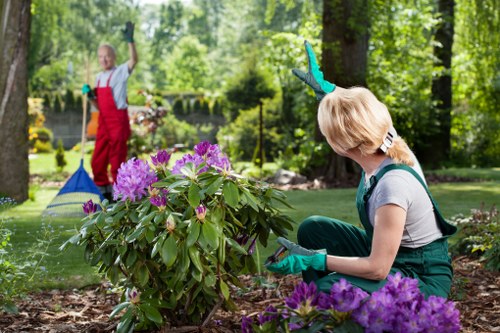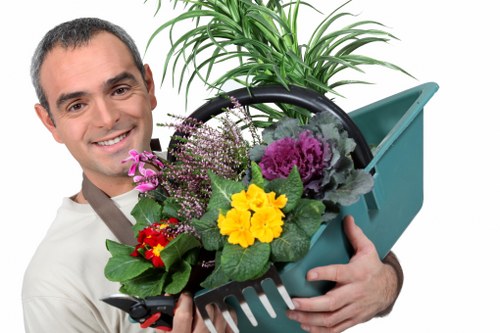Gardeners Hammersmith: Cultivating Green Spaces in the Heart of London

Hammersmith, a vibrant district in West London, is renowned for its lush gardens and green spaces. Gardeners in Hammersmith play a pivotal role in maintaining the area's beauty, ensuring that both public parks and private gardens flourish throughout the year.
Whether you’re a seasoned horticulturist or a gardening enthusiast, understanding the unique challenges and opportunities in Hammersmith can enhance your gardening experience. From the local climate to the diverse plant species, Gardeners Hammersmith navigate a variety of factors to create stunning landscapes.
In this article, we'll delve into the essentials of gardening in Hammersmith, explore the best practices, and highlight the communities and resources available to support local gardeners.

Understanding the Hammersmith Climate
Hammersmith enjoys a temperate maritime climate, characterized by mild winters and cool summers. This climate is generally conducive to a wide range of plant species, allowing gardeners to cultivate diverse gardens.
However, gardeners must be mindful of occasional rainfall and the relatively short growing season compared to other regions. Selecting plants that are resilient and adaptable to these conditions is key to successful gardening in Hammersmith.
Local gardeners often prefer native plants and those that require minimal maintenance, ensuring that their gardens remain vibrant with less effort. Understanding the microclimates within Hammersmith can also help in placing plants in locations where they will thrive the most.

Essential Gardening Tips for Hammersmith
Soil Preparation
Healthy soil is the foundation of any successful garden. In Hammersmith, gardeners should focus on enriching the soil with organic matter such as compost and well-rotted manure. This not only improves soil structure but also enhances nutrient availability for plants.
Irrigation Techniques
Efficient watering is crucial, especially during the drier summer months. Drip irrigation systems and rainwater harvesting are popular methods among Hammersmith gardeners to conserve water and ensure that plants receive consistent moisture.
Pest Management
Maintaining a healthy garden involves proactive pest management. Gardeners Hammersmith often utilize integrated pest management (IPM) strategies, combining biological controls with minimal use of chemical pesticides to protect their plants.

Popular Plants in Hammersmith Gardens
The selection of plants is vital in creating a thriving garden. Hammersmith gardeners favor a mix of perennials, annuals, shrubs, and trees that are well-suited to the local climate.
- Roses: A favorite for their beauty and fragrance.
- Lavender: Known for its lovely scent and hardiness.
- Boxwood: Ideal for creating structured hedges and topiaries.
- Hostas: Perfect for shaded areas with their lush foliage.
- Ornamental Grasses: Add texture and movement to gardens.
These plants not only enhance the aesthetic appeal but also contribute to the ecological diversity of Hammersmith’s green spaces.

Community and Resources for Gardeners in Hammersmith
Being part of a gardening community can greatly enhance your gardening experience. Hammersmith offers various resources and groups that support local gardeners.
Local Gardening Clubs
Joining a gardening club provides access to shared knowledge, events, and opportunities to collaborate on community projects. These clubs often host workshops and plant exchanges, fostering a sense of community among gardeners.
Public Gardens and Parks
Hammersmith is home to several public gardens and parks that serve as inspiration and learning grounds for gardeners. Visiting these spaces can offer new ideas and techniques to incorporate into your own garden.
Gardening Centers and Nurseries
Local gardening centers and nurseries in Hammersmith provide a wide range of plants, tools, and expert advice. These establishments are invaluable for sourcing quality materials and receiving guidance tailored to the local climate.
Challenges Faced by Gardeners in Hammersmith
While gardening in Hammersmith is rewarding, it comes with its set of challenges. Urban gardening often means limited space, so creative solutions are necessary to maximize greenery.
Balancing aesthetics with practicality is another common challenge. Ensuring that gardens are both beautiful and functional requires thoughtful planning and design.
Additionally, gardeners must stay informed about local regulations and conservation efforts to ensure that their practices are sustainable and environmentally friendly.
Innovative Gardening Solutions in Hammersmith
To overcome urban gardening challenges, Hammersmith gardeners are employing innovative solutions such as vertical gardening, container gardening, and community gardens.
Vertical Gardening
Utilizing vertical space allows gardeners to grow more plants in limited areas. Trellises, wall-mounted planters, and hanging baskets are popular methods for vertical gardening in Hammersmith.
Container Gardening
Containers offer flexibility and mobility, making them ideal for urban settings. Gardeners can easily adjust the placement of containers to optimize sun exposure and drainage.
Community Gardens
Community gardens provide shared spaces where neighbors can collaborate and grow a variety of plants. These gardens foster community spirit and promote sustainable gardening practices.
Local Gardening Events and Workshops
Hammersmith hosts numerous gardening events and workshops throughout the year, offering opportunities for gardeners to learn and connect.
- Spring Planting Workshops: Learn about seasonal planting and garden preparation.
- Summer Garden Tours: Explore beautiful gardens and gain inspiration.
- Autumn Harvest Festivals: Celebrate the season's bounty with fellow gardeners.
- Winter Care Seminars: Tips on protecting plants during colder months.
Participating in these events helps gardeners stay updated on the latest trends and techniques in gardening.
Gardening Tools and Equipment
Having the right tools is essential for any gardener. In Hammersmith, gardeners prioritize quality and functionality to maintain their green spaces effectively.
Essential Tools
- Pruning Shears: For trimming and shaping plants.
- Garden Fork: Ideal for turning and aerating soil.
- Watering Cans: Essential for providing plants with the necessary moisture.
- Gloves: Protect hands while working with soil and plants.
- Wheelbarrows: Helpful for transporting soil, compost, and plants.
Investing in high-quality gardening tools can make maintenance tasks easier and more efficient.
Sustainable Gardening Practices
Sustainability is a key focus for gardeners in Hammersmith. Implementing eco-friendly practices ensures that gardens are not only beautiful but also environmentally responsible.
Composting
Composting organic waste reduces landfill usage and provides nutrient-rich soil for gardens. Gardeners in Hammersmith often set up compost bins to recycle kitchen scraps and garden waste.
Rainwater Harvesting
Collecting rainwater for irrigation conserves water and reduces utility bills. Rain barrels and other collection systems are popular among local gardeners.
Native Plant Integration
Using native plants supports local wildlife and reduces the need for excessive watering and fertilization. Native species are well-adapted to the local climate, making them easier to maintain.
Gardening for Mental Health
Gardening offers numerous mental health benefits, providing a therapeutic and fulfilling hobby for many residents of Hammersmith.
Engaging with nature through gardening can reduce stress, improve mood, and enhance overall well-being. It also fosters a sense of accomplishment and connection to the community.
Many gardeners find solace in the routine and patience required for gardening, making it a valuable activity for maintaining mental health.
Connecting with Other Gardeners in Hammersmith
Building connections with fellow gardeners enriches the gardening experience. Sharing tips, plant swaps, and collaborative projects strengthens the community.
Social media groups and local forums provide platforms for gardeners to exchange ideas and support each other. These connections can lead to lifelong friendships and a more vibrant gardening community.
Participating in local events and workshops also offers opportunities to meet other gardening enthusiasts and expand your knowledge.
Local Regulations and Gardening in Hammersmith
Understanding and adhering to local regulations is important for maintaining gardens that comply with Hammersmith's standards.
Regulations may pertain to the size of fences, the height of hedges, and the use of certain plants. Gardeners should familiarize themselves with these rules to avoid potential fines and ensure harmonious neighborhood relations.
Additionally, participating in local conservation efforts helps preserve the area's natural beauty and supports sustainable gardening practices.
Top 15 Nearby Areas to Hammersmith for Gardeners
Hammersmith is surrounded by several neighborhoods, each offering unique features and opportunities for gardeners. Here are the top 15 nearby areas:
- Shepherd's Bush: Known for its vibrant community gardens and urban green spaces.
- Fulham: Offers a mix of private and public gardens with a focus on ornamental plants.
- Chiswick: Features spacious parks and riverfront gardens perfect for outdoor activities.
- West Kensington: Home to well-maintained garden squares and botanical nurseries.
- Barons Court: Known for its quiet residential gardens and tree-lined streets.
- Palace Gate: Offers private gardens with a variety of plant species and landscapes.
- Little Venice: Features picturesque canal-side gardens ideal for relaxation and inspiration.
- Holland Park: Hosts one of London’s most famous gardens, including the Kyoto Garden.
- Brentford: Offers community-led gardening projects and green initiatives.
- Acton: Known for its diverse plant selections and eco-friendly gardening practices.
- Kew: Home to the renowned Royal Botanic Gardens, a haven for plant enthusiasts.
- Stamford Brook: Features small community gardens and green spaces perfect for neighborhood gatherings.
- Ealing: Offers extensive parks and gardens with a variety of plant life.
- Paddington: Known for its rooftop gardens and innovative urban gardening solutions.
- White City: Features modern garden installations and sustainable gardening projects.
Each of these areas provides unique opportunities for gardeners, from expansive public parks to intimate community gardens, catering to a wide range of gardening interests.
Conclusion
Gardening in Hammersmith is a rewarding endeavor that combines beauty, community, and sustainability. By understanding the local climate, utilizing effective gardening practices, and connecting with fellow gardeners, you can create and maintain stunning green spaces in this vibrant part of London.
Embrace the challenges and opportunities that come with urban gardening, and contribute to the flourishing greenery that makes Hammersmith a delightful place to live and visit.
Frequently Asked Questions
1. What are the best plants to grow in Hammersmith’s climate?
Plants that thrive in Hammersmith’s temperate maritime climate include roses, lavender, boxwood, hostas, and ornamental grasses. These plants are well-suited to the mild winters and cool summers of the area.
2. How can I conserve water in my Hammersmith garden?
Implementing drip irrigation systems, using rain barrels for water collection, and selecting drought-resistant plants are effective ways to conserve water in your garden.
3. Are there any community gardening projects in Hammersmith?
Yes, Hammersmith has several community gardening projects where residents can collaborate, share resources, and cultivate communal green spaces. Joining local gardening clubs or groups can help you get involved.
4. What resources are available for new gardeners in Hammersmith?
Local gardening centers, nurseries, and gardening clubs provide resources and support for new gardeners. Additionally, attending workshops and events can offer valuable knowledge and hands-on experience.
5. How do I handle pests in my Hammersmith garden naturally?
Using integrated pest management (IPM) strategies, such as introducing beneficial insects, using organic pesticides, and maintaining plant health, can help manage pests naturally and effectively.


